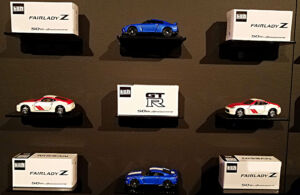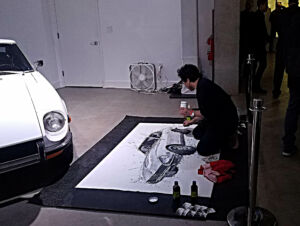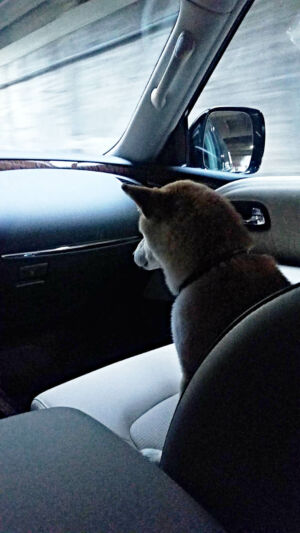First, I knew I wanted to make the cars patriotic to America. In the ‘60s it had only been 20 years since WWII ended and there was still some sensitivity to the Japanese, especially on the West coast. I wanted to make sure the cars came across as loyal to America so went with the red, white and blue paint scheme.
Next, I wanted to make the graphics bold. Keep in mind a race car will only be seen for a few seconds at a time and spectators are a distance away so you want major impact. I would stripe off a car with tape and walk across the street to see if the size of the stripes, overhang of the color over the sides and numbers were easy to identify.
Then I wanted to make the cars look more streamline. I did this by bringing the top color over the sides of the car a couple of inches and painting the rocker panels at the bottom of the cars black. A person looking at the cars would see the “sides” of the car as the white painted portion and these techniques made the car look more sleek.
 I also wanted the cars to look fast and that’s where the angled side stripes came in. They not only gave the cars the impression of speed, but being the reverse angle of the windscreen they gave the impression of an arrow from a distance. A person doesn’t consciously notice any of these details but the overall impression is impactful.
I also wanted the cars to look fast and that’s where the angled side stripes came in. They not only gave the cars the impression of speed, but being the reverse angle of the windscreen they gave the impression of an arrow from a distance. A person doesn’t consciously notice any of these details but the overall impression is impactful.
 Being a factory-based team, marketing coverage was important. Every aspect of the car needed to photograph well. That’s why I had the entire exhaust system, which was a work of art, painted bright yellow and the inside of the engine compartment painted white so all details of these great cars the BRE team built could be clearly seen and appreciated.
Being a factory-based team, marketing coverage was important. Every aspect of the car needed to photograph well. That’s why I had the entire exhaust system, which was a work of art, painted bright yellow and the inside of the engine compartment painted white so all details of these great cars the BRE team built could be clearly seen and appreciated.
Speaking of the car photographing well, the cars needed to stand out from the track so I had a rim of white painted along the outside edge of the front spoilers. This made the front spoiler pop out from the black asphalt of a track. 
If someone doesn’t want to copy the BRE graphics, what guidelines would you offer them?
• Decide on the purpose of the graphics. Is it to enhance the design of the car (as it was with BRE as we were promoting the cars for Datsun/Nissan) or is it to be a signboard (e.g. promoting a sponsor) where the graphics are unrelated to the car. Decide which and stick to it.
• No matter what the purpose, you want the car to photograph well for social media, articles, etc. Don’t make the common mistake of designing the graphics standing next to the car. I’ve seen graphics that are really beautiful when you’re three feet from the car (e.g. waving flag) that spectators, tv cameras, etc can’t identify as the car races by on the track. Mock-up your design on the car and look at it at least 50 feet back.
• Avoid major contrasting colors like black and white. A camera will either shutout light so details in the white show but that will cause the black areas to have no definition or the camera will open-up to get as much light in to see details in the black and the white areas of the car will flare out.
 • The colors you use will be dictated by purpose. Again, do you just want the car to be striking and attention getting or is it to tell a story, advertise a sponsor, promote a country, etc. If the latter, the colors you use are probably dictated by a sponsor’s colors, the colors of a flag and so on. If you have total freedom on colors my recommendation is go to a tropical fish store. Nature knows what goes together best and you’ll be knocked out by color combinations you’ll find on fish.
• The colors you use will be dictated by purpose. Again, do you just want the car to be striking and attention getting or is it to tell a story, advertise a sponsor, promote a country, etc. If the latter, the colors you use are probably dictated by a sponsor’s colors, the colors of a flag and so on. If you have total freedom on colors my recommendation is go to a tropical fish store. Nature knows what goes together best and you’ll be knocked out by color combinations you’ll find on fish.
• If you do decide you want to make a BRE Tribute car, contact us to become a member of our BRE Tribute Car program. We provide paint colors, sponsor decals, numbers (even custom numbers I create myself to make sure the shapes and perspectives are correct).


































